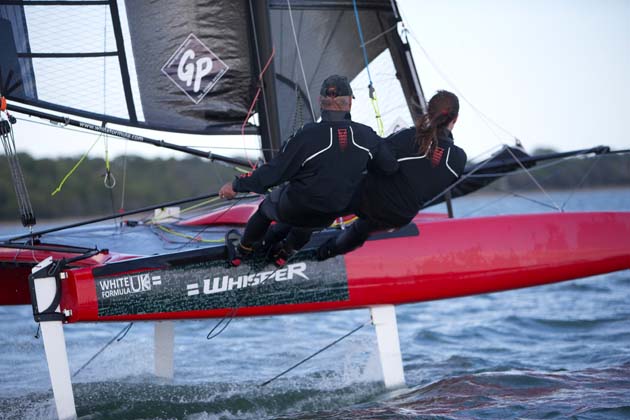No matter how safe they say it is, there are some of us who like our comfort zone to be a little more comfortable, says Matthew Sheahan after a ride aboard the Solent Whisper
As the back end of the 200bhp rear wheel drive Toyota GT86 snapped out and the car started to spin like a roulette wheel and slide towards the perimeter fence, I was suddenly outside my comfort zone. My whole world had transformed from the familiarity of a modern car to an unfamiliar, blurred vision of a grass bank and fencing that was now rushing past.
The snap change from a gentle sideways drift on the purpose-built skid pan, where up until now opposite lock had kept the car in line, had changed instantly into a wild fairground ride, from fun to fear in a split second after I had accidentally dabbed the throttle.
Earlier in the week I had had a similar experience aboard a new foiling catamaran, the Solent Whisper (see the full report and video).
On the face of it the cat looked like many other modern boats of her type and the transition from displacement sailing to full foiling mode was far smoother than I had expected.

But, in the gusty conditions on the day of the test and with one of the ride height controls sticking at a certain point, she occasionally switched from smooth flight to a rapid nosedive. There was no problem, as her designer had pointed out before we left, she was very forgiving, but just as with the car, the split second transition from new normal to ‘Oh my God!’ was enough to remind me how different this beast was and how far outside the norm I had strayed.
Pushing the boundaries
Yet for some, this kind of behaviour is indeed perfectly normal. For the instructor at the Thruxton motorsport centre and the creator of the fascinating Solent Whisper, Ron Price, pushing way beyond the commonly accepted boundaries is their world.

And there are some who want to push even further. During an interview with Dongfeng Racing skipper Charles Caudrelier last year in the Volvo Ocean Race, we got chatting about the future of racing round the world.
“I want to be the first to fly across the Atlantic,” he declared, but he didn’t mean in an aircraft. “I am very interested in hydrofoils.
“My first dream was to do the Route du Rhum in a multihull, but I think one day the Volvo Ocean Race will be in multihulls. Sailing at 20 knots as we do at the moment is too slow. I think it is also safer to sail in the Southern Ocean at 30 knots on a big multihull than it is at 25 knots in a Volvo 65.
“In a modern multihull designed for oceans you don’t have to push too much, you are very well protected in a boat that is, say, a 25m version of the maxi trimaran Groupama 3 [now Spindrift 2]. You will be quite safe.”
She was very forgiving, but just as with the car, the split second transition from the new normal to ‘Oh my God!’ was enough to remind me how different this beast was from anything I’d sailed before
As a former crewmember aboard the giant tri, he should know. But, as if emphasising how far those with the knowledge are now happy to push, Caudrelier thinks the future lies with foiling.
“Flying is going to be safe. Everyone thinks it is dangerous, but I am involved with a project and have been surprised by the results. Maybe it’s a bit too early now, but I believe in ten years flying will be normal.”
Water impact protection
But it’s not just the designers, builders and sailors who are preparing for a very different future. Forward WIP is a new company for sailing clothing that specialises in water impact protection, or as their website likes to describe it ‘protection gear for falling safely’.
The world is clearly changing quickly.
What they don’t appear to have in their comprehensive list of body armour, helmets and specialist suits is a range of replacement trousers, which would have been useful in both my recent experiences.
I guess some people are already more comfortable with the future than others.
See Matt’s History of Foiling HERE




